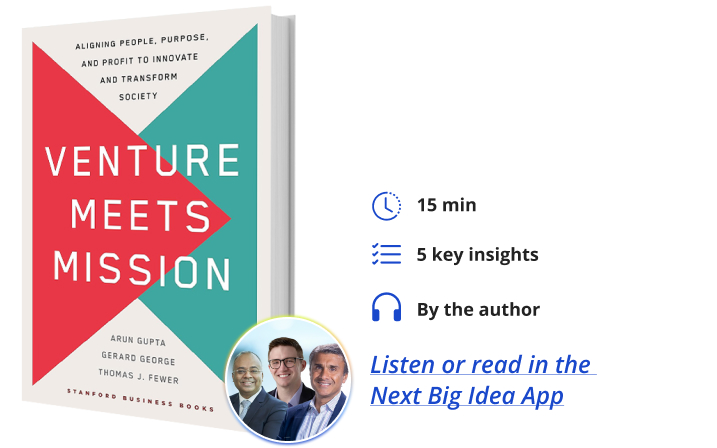Arun is a venture capitalist, Lecturer at Stanford University, and Adjunct Entrepreneurship Professor at Georgetown University. He is CEO of NobleReach Foundation, which is focused on catalyzing and inspiring a renewed spirit of national service through innovation.
Gerard (Gerry) George is the Tamsen and Michael Brown Family Professor of Entrepreneurship and Innovation at Georgetown University and Senior Advisor at TPG, a leading global alternative asset manager.
Thomas J. Fewer is a Postdoctoral Fellow in the Georgetown Entrepreneurship Initiative at Georgetown University and VP at NobleReach Foundation, focused on developing innovative talent programs to educate and inspire the next generation of mission-driven changemakers.
Below, co-authors Arun, Gerry, and Thomas share 5 key insights from their new book, Venture Meets Mission: Aligning People, Purpose, and Profit to Innovate and Transform Society. Listen to the audio version—read by Arun—in the Next Big Idea App.

1. Today’s most pressing challenges require a renewed partnership between government and entrepreneurs.
Technologically, geopolitically, and socially, we need a renewed partnership that brings together the innovative nature of entrepreneurship with the scale of government. Recent substantial innovation initiatives signaled an opportunity to bring together both the government and inventors to solve these problems in a for-profit manner. Traditional public-private partnership models employ government with large companies. But as we look to create a renewed partnership between government, ventures and entrepreneurs, we need a new model, a government-venture arrangement, that takes this into account and allows us to take advantage of the strategic differentiation.
2. We must humanize government and personalize entrepreneurship.
Bringing together government and venture also means addressing deep-rooted biases about what government is and who entrepreneurs are. For this partnership to work, we must humanize government and personalized entrepreneurship for both groups.
Small subsets are mistakenly conflated as representing the entire group. For example, we mistakenly conflate entrepreneurship with simply being the billionaire class. But in truth, we are all entrepreneurs. Entrepreneurship is not an outcome. It’s a mindset.
“Small subsets are mistakenly conflated as representing the entire group.”
Likewise, we sometimes conflate government with being the radical voices that we see from our political establishment. However, when you think about it, government is simply an organization comprised of people. There’s a difference between civil servants and politicians. Civil servants go in day-to-day with positive intent, looking to serve the people in the society of this country.
3. Accelerating innovation demands comfort with risk.
The risk profiles of venture capital and government are vastly different. This is an important distinction in how we think about their capacity to innovate. For example, I joke around as a venture capitalist that if I were measured the way the government was, I would never raise another fund.
As a venture capitalist, we’re measured on our best successes. If I make 10 bets and two are home runs, I’m oversubscribed to another fund. Whereas with government, if I make 10 bets and one of them is a failure, I’m carrying that with me for a decade. Likewise, we have to understand that each government agency has an inspector general, and their job is to ensure that each agency is adhering to its processes. They ensure that each agency is not steering off course. That creates a more risk-averse culture within the agency.
One of my colleagues, Dan Tango, said it would be great if each agency had two inspectors. The idea is that the second one could function as an innovation general. Imagine changing the culture of an agency if you could also be brought in front of a congressional hearing for not innovating fast enough. Innovation requires the willingness to take risks and fail periodically.
4. What if the next generation of students, especially tech students, were excited to start their careers in government, and government was perceived as a career enhancer?
Take two examples. First is a computer science student selected to do Kessel Run, a prominent military program. She tells her friend about it, and her friends ask, “Why would you do that? Why would you do that when you can do something else?” Her other friend, also a CS major, was selected to do Teach for America, and her friends say, “Wow, that’s amazing. You’re going to serve. You’re going to give back, and then you can go do whatever you want.”
What if we changed the “why” to “wow”? Our vernacular reinforces this artificial binary choice of doing well versus doing good for profit, not for profit. The options are private sector or public sector. One’s about making money, and the other one’s about doing good.
“The government is selling jobs, but the students are seeking missions.”
What if we created a place where you could do both? The government sells careers to students, but the students are buying experiences. The government is selling jobs, but the students are seeking missions. What if the “wow” with creating mission-oriented experiences was a priority for this next generation of students? For example, agencies today will list a data analyst job with geospatial specialization. What that same person would be doing if we’re building food systems in Ukraine is using satellite data. That changes the “why” to “wow.”
5. Democracy’s superpower is our higher education and venture ecosystem.
The U.S. and its allies have a natural competitive advantage here and should be investing and leveraging these talent creation and innovation models. Nowhere else in the world do we have the ability to create talent like we do here in the U.S. This is evidenced by the number of people that want to come here for higher education. Nowhere else in the world do we have an entrepreneurial ecosystem like we do here in the U.S. This is evidenced by the number of people that want to come to the U.S. to create new companies.
It is difficult for global adversaries to replicate this because these features are foundational to liberal democracy. Knowledge creation and innovation challenge the status quo, relies on free and open exchange of ideas, and thrives when people are willing to take risks. These three features are fundamental to democracies. Our higher education system and our entrepreneurial ecosystem are our strategic superpowers in this country, and it’s time that we align that to solve our largest societal problems.
To listen to the audio version read by co-author Arun Gupta, download the Next Big Idea App today:































